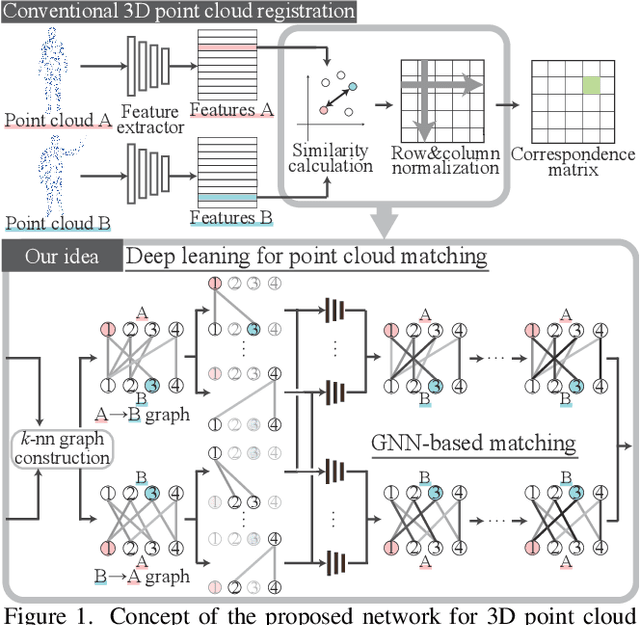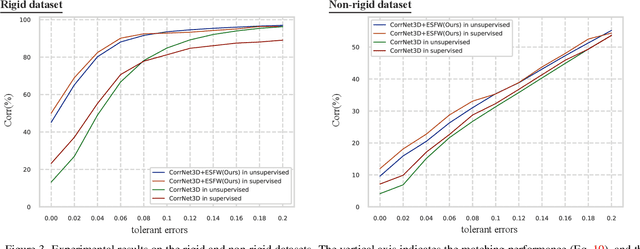Naoya Chiba
MRHaD: Mixed Reality-based Hand-Drawn Map Editing Interface for Mobile Robot Navigation
Apr 01, 2025Abstract:Mobile robot navigation systems are increasingly relied upon in dynamic and complex environments, yet they often struggle with map inaccuracies and the resulting inefficient path planning. This paper presents MRHaD, a Mixed Reality-based Hand-drawn Map Editing Interface that enables intuitive, real-time map modifications through natural hand gestures. By integrating the MR head-mounted display with the robotic navigation system, operators can directly create hand-drawn restricted zones (HRZ), thereby bridging the gap between 2D map representations and the real-world environment. Comparative experiments against conventional 2D editing methods demonstrate that MRHaD significantly improves editing efficiency, map accuracy, and overall usability, contributing to safer and more efficient mobile robot operations. The proposed approach provides a robust technical foundation for advancing human-robot collaboration and establishing innovative interaction models that enhance the hybrid future of robotics and human society. For additional material, please check: https://mertcookimg.github.io/mrhad/
Focused Blind Switching Manipulation Based on Constrained and Regional Touch States of Multi-Fingered Hand Using Deep Learning
Mar 10, 2025Abstract:To achieve a desired grasping posture (including object position and orientation), multi-finger motions need to be conducted according to the the current touch state. Specifically, when subtle changes happen during correcting the object state, not only proprioception but also tactile information from the entire hand can be beneficial. However, switching motions with high-DOFs of multiple fingers and abundant tactile information is still challenging. In this study, we propose a loss function with constraints of touch states and an attention mechanism for focusing on important modalities depending on the touch states. The policy model is AE-LSTM which consists of Autoencoder (AE) which compresses abundant tactile information and Long Short-Term Memory (LSTM) which switches the motion depending on the touch states. Motion for cap-opening was chosen as a target task which consists of subtasks of sliding an object and opening its cap. As a result, the proposed method achieved the best success rates with a variety of objects for real time cap-opening manipulation. Furthermore, we could confirm that the proposed model acquired the features of each subtask and attention on specific modalities.
Crystalformer: Infinitely Connected Attention for Periodic Structure Encoding
Mar 18, 2024



Abstract:Predicting physical properties of materials from their crystal structures is a fundamental problem in materials science. In peripheral areas such as the prediction of molecular properties, fully connected attention networks have been shown to be successful. However, unlike these finite atom arrangements, crystal structures are infinitely repeating, periodic arrangements of atoms, whose fully connected attention results in infinitely connected attention. In this work, we show that this infinitely connected attention can lead to a computationally tractable formulation, interpreted as neural potential summation, that performs infinite interatomic potential summations in a deeply learned feature space. We then propose a simple yet effective Transformer-based encoder architecture for crystal structures called Crystalformer. Compared to an existing Transformer-based model, the proposed model requires only 29.4% of the number of parameters, with minimal modifications to the original Transformer architecture. Despite the architectural simplicity, the proposed method outperforms state-of-the-art methods for various property regression tasks on the Materials Project and JARVIS-DFT datasets.
A Transformer Model for Symbolic Regression towards Scientific Discovery
Dec 13, 2023



Abstract:Symbolic Regression (SR) searches for mathematical expressions which best describe numerical datasets. This allows to circumvent interpretation issues inherent to artificial neural networks, but SR algorithms are often computationally expensive. This work proposes a new Transformer model aiming at Symbolic Regression particularly focused on its application for Scientific Discovery. We propose three encoder architectures with increasing flexibility but at the cost of column-permutation equivariance violation. Training results indicate that the most flexible architecture is required to prevent from overfitting. Once trained, we apply our best model to the SRSD datasets (Symbolic Regression for Scientific Discovery datasets) which yields state-of-the-art results using the normalized tree-based edit distance, at no extra computational cost.
WeaveNet for Approximating Two-sided Matching Problems
Oct 19, 2023Abstract:Matching, a task to optimally assign limited resources under constraints, is a fundamental technology for society. The task potentially has various objectives, conditions, and constraints; however, the efficient neural network architecture for matching is underexplored. This paper proposes a novel graph neural network (GNN), \textit{WeaveNet}, designed for bipartite graphs. Since a bipartite graph is generally dense, general GNN architectures lose node-wise information by over-smoothing when deeply stacked. Such a phenomenon is undesirable for solving matching problems. WeaveNet avoids it by preserving edge-wise information while passing messages densely to reach a better solution. To evaluate the model, we approximated one of the \textit{strongly NP-hard} problems, \textit{fair stable matching}. Despite its inherent difficulties and the network's general purpose design, our model reached a comparative performance with state-of-the-art algorithms specially designed for stable matching for small numbers of agents.
NeuralLabeling: A versatile toolset for labeling vision datasets using Neural Radiance Fields
Sep 21, 2023



Abstract:We present NeuralLabeling, a labeling approach and toolset for annotating a scene using either bounding boxes or meshes and generating segmentation masks, affordance maps, 2D bounding boxes, 3D bounding boxes, 6DOF object poses, depth maps and object meshes. NeuralLabeling uses Neural Radiance Fields (NeRF) as renderer, allowing labeling to be performed using 3D spatial tools while incorporating geometric clues such as occlusions, relying only on images captured from multiple viewpoints as input. To demonstrate the applicability of NeuralLabeling to a practical problem in robotics, we added ground truth depth maps to 30000 frames of transparent object RGB and noisy depth maps of glasses placed in a dishwasher captured using an RGBD sensor, yielding the Dishwasher30k dataset. We show that training a simple deep neural network with supervision using the annotated depth maps yields a higher reconstruction performance than training with the previously applied weakly supervised approach.
Rethinking Symbolic Regression Datasets and Benchmarks for Scientific Discovery
Jun 21, 2022



Abstract:This paper revisits datasets and evaluation criteria for Symbolic Regression, a task of expressing given data using mathematical equations, specifically focused on its potential for scientific discovery. Focused on a set of formulas used in the existing datasets based on Feynman Lectures on Physics, we recreate 120 datasets to discuss the performance of symbolic regression for scientific discovery (SRSD). For each of the 120 SRSD datasets, we carefully review the properties of the formula and its variables to design reasonably realistic sampling range of values so that our new SRSD datasets can be used for evaluating the potential of SRSD such as whether or not an SR method con (re)discover physical laws from such datasets. As an evaluation metric, we also propose to use normalized edit distances between a predicted equation and the ground-truth equation trees. While existing metrics are either binary or errors between the target values and an SR model's predicted values for a given input, normalized edit distances evaluate a sort of similarity between the ground-truth and predicted equation trees. We have conducted experiments on our new SRSD datasets using five state-of-the-art SR methods in SRBench and a simple baseline based on a recent Transformer architecture. The results show that we provide a more realistic performance evaluation and open up a new machine learning-based approach for scientific discovery. Our datasets and code repository are publicly available.
Edge-Selective Feature Weaving for Point Cloud Matching
Feb 08, 2022



Abstract:This paper tackles the problem of accurately matching the points of two 3D point clouds. Most conventional methods improve their performance by extracting representative features from each point via deep-learning-based algorithms. On the other hand, the correspondence calculation between the extracted features has not been examined in depth, and non-trainable algorithms (e.g. the Sinkhorn algorithm) are frequently applied. As a result, the extracted features may be forcibly fitted to a non-trainable algorithm. Furthermore, the extracted features frequently contain stochastically unavoidable errors, which degrades the matching accuracy. In this paper, instead of using a non-trainable algorithm, we propose a differentiable matching network that can be jointly optimized with the feature extraction procedure. Our network first constructs graphs with edges connecting the points of each point cloud and then extracts discriminative edge features by using two main components: a shared set-encoder and an edge-selective cross-concatenation. These components enable us to symmetrically consider two point clouds and to extract discriminative edge features, respectively. By using the extracted discriminative edge features, our network can accurately calculate the correspondence between points. Our experimental results show that the proposed network can significantly improve the performance of point cloud matching. Our code is available at https://github.com/yanarin/ESFW
 Add to Chrome
Add to Chrome Add to Firefox
Add to Firefox Add to Edge
Add to Edge